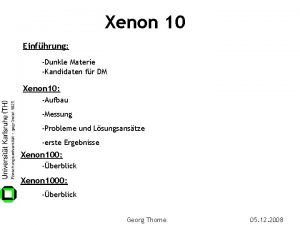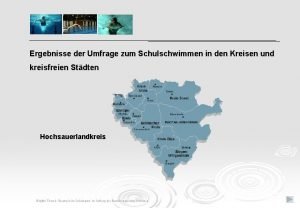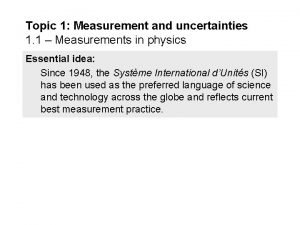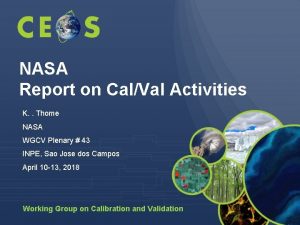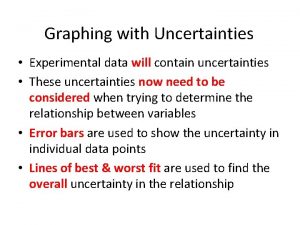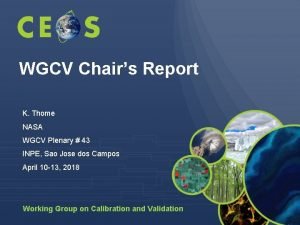Uncertainties for Analysis Ready Data K Thome NASA






- Slides: 6

Uncertainties for Analysis Ready Data K. . Thome NASA WGCV Plenary # 43 INPE, Sao Jose dos Campos April 10 -13, 2018 Working Group on Calibration and Validation

Uncertainties for Analysis Ready Data WGCV-43 • Work Plan activities are emphasizing analysis ready data § CEOS Analysis Ready Data § Interoperable free and open tools § Data, processing, and architecture standards § Analytical processing capabilities § User Metrics FDA-7: Product Specifications in accordance with the CARD 4 L Framework Q 4 CEOS Analysis Ready Data for Land (CARD 4 L) will be satellite LSI-VC 2017 data that have been processed to a minimum set of (with requirements and organized into a form that allows WGCV) immediate analysis with a minimum of additional user effort, and, interoperability both through time and with other datasets. LSI-VC will commence development of the first concrete specifications for CARD 4 L-branded products, with at least two such specification documents presented for endorsement at the 31 st CEOS Plenary Meeting. Draft versions of these specifications will be used to inform LSI-VC contributions to FDA-4. Working Group on Calibration and Validation 2

Uncertainties for Analysis Ready Data WGCV-43 Future Data Architecture FDA-12: Inventory of space data product formats used by CEOS agencies. Q 4 Develop an inventory of current product format used in CEOS WGCV 2019 agencies and identify recommendations to facilitate interoperability Working Group on Calibration and Validation 3

Uncertainties for Analysis Ready Data WGCV-43 Capacity Building, Data Access, Availability and Quality CV-15: L 1 top-ofatmosphere interoperability Q 4 2017 CV-17: Continental scale Q 2 surface reflectance 2019 validation Develop an initial recommendation of a community reference in collaboration with GSICS. Provide guidance for development of methodologies to validate the results of the recent ACIX work leading to protocols for determining uncertainties for interoperable reflectnce products. WGCV Working Group on Calibration and Validation 4

Uncertainties for Analysis Ready Data WGCV-43 VC-30: Q 4 Interoperability 2018 case study for Landsat and Sentinel-2 While monitoring existing MRI efforts by agencies LSI-VC (including the MRI framework for moderate resolution with land sensor interoperability (refer VC-29) applied to the WGCV Landsat and Sentinel-2 missions) develop the long-term plans and actions for MRI, as well as identify any expansion of MRI to other sensors. • Furthering the framework under considerations of the agreed principles and expanding it to other sensors with a focus on moderate resolution SAR. • Analyzing various past/ongoing implementations (NASA HLS, ESA HSL, …) for MRI framework compliance. Initiating detailed assessments of various implementation options (common grid, spectral & temporal adjustments). Working Group on Calibration and Validation 5

Uncertainties for Analysis Ready Data WGCV-43 Try to avoid bogging down in definition of ARD, MRI, data cube • • Identify key questions to answer that lead to the assessment of uncertainties in surface reflectance Identify key questions to answer that lead to assessment of surface reflectance validation This can be a large effort Make this more manageable by determining a set of starting points • CARD 4 L as the definition of what an ARD is and what is needed to develop a “suitable” ARD • Provide guidance on how CARD 4 L products can be evaluated against their requirements • Incorporate the Level 1 interoperability discussion because the next step in ARD is to allow an ARD from multiple sensors to be developed Working Group on Calibration and Validation 6
